Excerpts from Jim Conrad's
Naturalist Newsletter
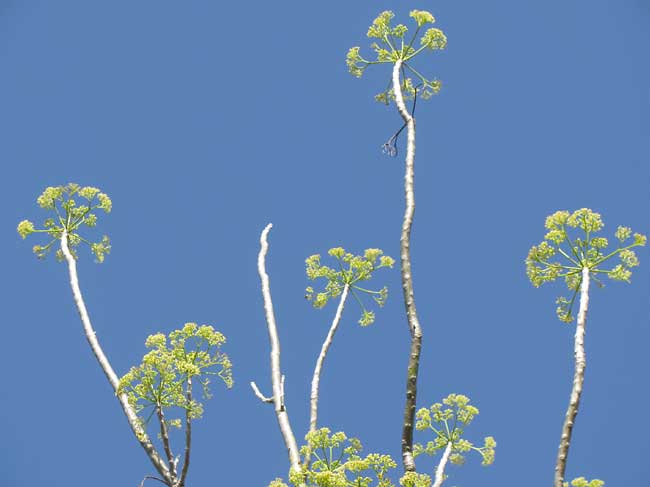
from the June 13, 2010 Newsletter issued from Hacienda Chichen Resort beside Chichén Itzá Ruins, central Yucatán, MÉXICO; limestone bedrock, elevation ~39m (~128ft), ~N20.676°, ~W88.569°
MYSTERIOUS HELICOPTER TREE
Items appearing in this Newsletter appear because I've been able to figure something out about them. There's an awful lot of very interesting stuff you never hear about just because I can't figure out what I'm seeing!
Since early March that's been the case with a certain tree species growing in Hacienda Chichen's Reserve. In the first or second week of March I came upon several thick-stemmed, dry-season-leafless, smallish trees about 15 feet tall (4.5m) in full flower, as shown above.
I'd never seen anything like that so I knocked down some flowers, of which only one was open. It was a tiny, unisexual male flower with three obvious stamens. Each stamen's two emptied anther cells were topped by roundish "ears" of a kind I've never seen -- maybe in wind they cause the anthers to shake out their pollen. Between the stamens were brown things I couldn't figure out. The whole thing is shown below:
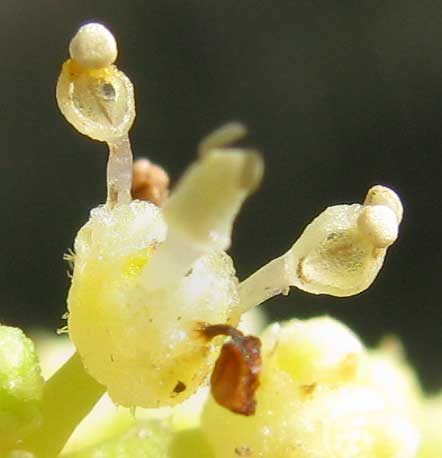
I spent hours on the Internet using all my botanical skills but finally I gave up. Then in early May -- along with many trees that had lost their leaves for the dry season -- the mystery trees appeared with both fruits and leaves, as mind-bogglingly shown below:
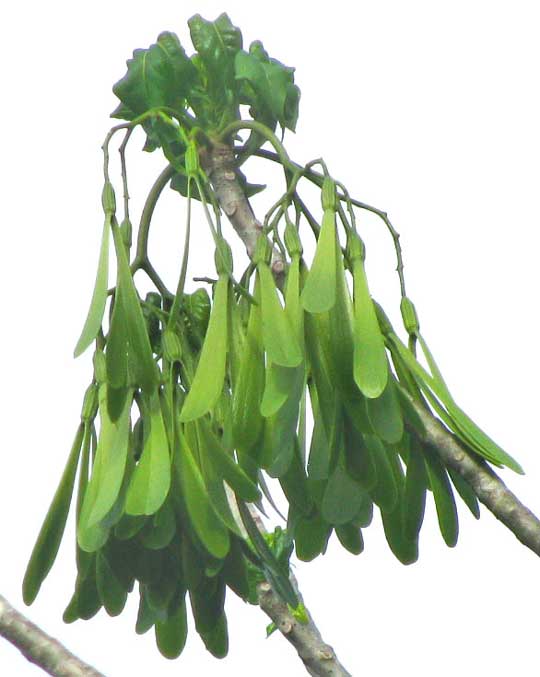
The leaves looked rather familiar, like the Chaya I eat each day, which is a member of the Euphorbia Family. But have you ever seen fruits anything like those? Each one-seeded, samara-type fruit bears two rabbit-ear wings, presumably to help with wind dispersal. Even with this extra information and more hours on the Internet, again I had to give up.
Finally this week the trees began dropping their mature, one-seeded fruits, some of which you can see below:
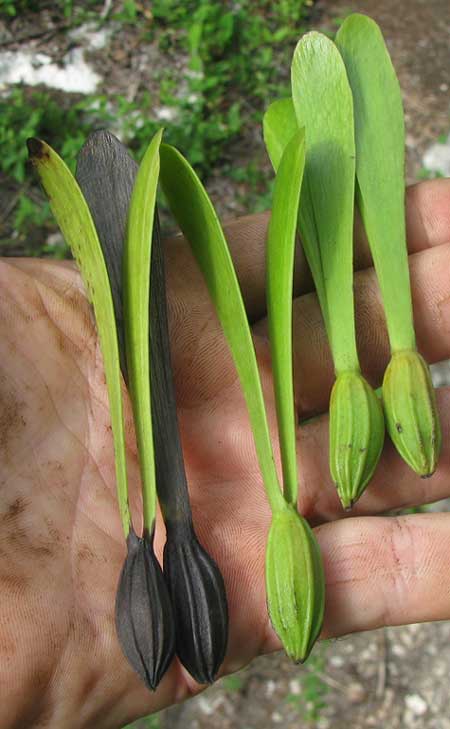
Also, now the leaves are expanded, revealing that they are "palmately lobed" -- with segments like thick fingers radiating from the palm of a hand -- as shown below:
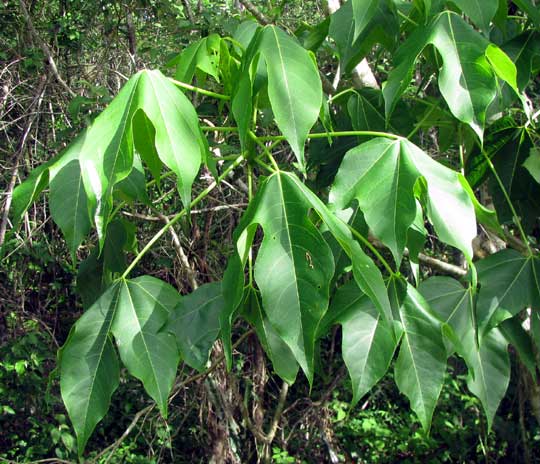
Having a mature fruit in hand, finally I've figured it out, and it's wonderful. The trees belong to a family I've never seen before, apparently referred to in English as the Hernandia Family, the Hernandiaceae. On the Phylogenetic Tree of Life the Hernandicaceae usually is placed near the Laurel Family. The tree itself is GYROCARPUS JATROPHIFOLIUS, and the only English name I can find for it is Helicopter Tree, referring to the way fruits spin in the wind as they fall. My Maya friends have nothing to say about it.
Helicopter Trees are spottily distributed throughout much of southern Mexico and Central America, but apparently nowhere are they common. Little is known about it. It's a great find, right here on Hacienda Chichen's Reserve.
And if anyone out there is an expert in weird tropical American trees, I have another species I'm stuck on as well... I'll gladly send pictures.
from the November 5, 2017 Newsletter, a special on-the-road edition with notes taken in mid October near Tepotzlán, Morelos state, MÉXICO
Elevation about 5315 ft (1620m), at 18°59′07″N 99°05′59″W
HELICOPTER TREE SURPRISE
During my mid-October visit with my friend near Tepotzlán, Morelos, just south of Mexico City, a certain tree caught my attention, apparently a naturally occurring one at the property's border, adjacent to a neighbor's cornfield. You can see it below:
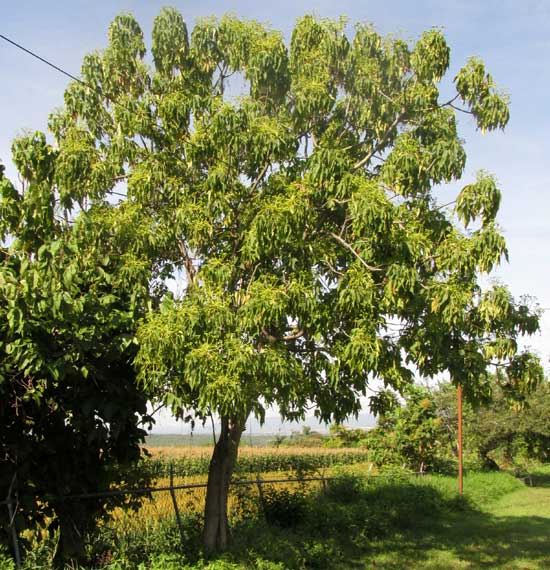
Notice that large, diffuse flowering clusters, or inflorescences, appear at branch tips. Not many trees display their flowers like this, so I went for a closer look. The flowers turned out to be very small, but bunched tightly at the tips of widely flaring, branching peduncles, seen below:
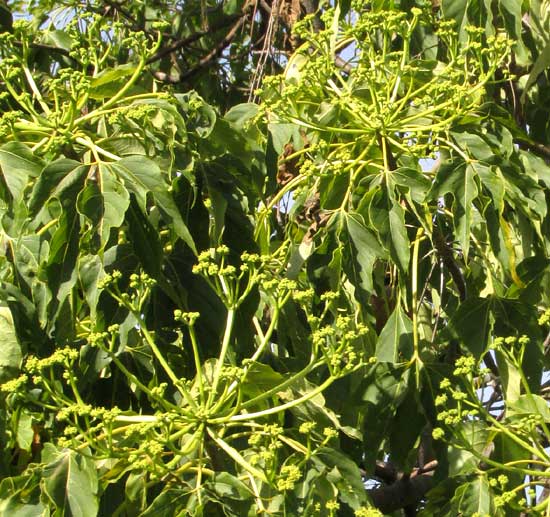
An open flower with its stalked anthers displaying remarkable cells from which pollen has been ejected is shown below:

Below, you can see one of the tree's large, star-shaped leaves:
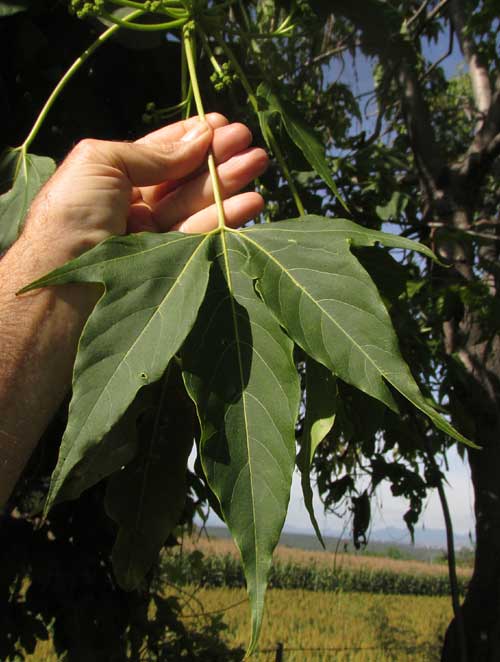
We've seen this remarkable species before, {previous section}, but our Yucatan trees had produced flowers on naked branches, while these Morelos ones are fully leafed when their flowers appear. At first I thought that maybe the Morelos ones were a different species, but then I found Adolfo Espejo Serna's 1991 work "Notas Sobre el Genero Gyrocarpus (Hernandiaceae) en Mexico..., " appearing in Acta Botánica Mexicana, 13:39-51, freely downloadable here.
Espejo makes clear that in Mexico we have two Gyrocarpus species, G. jatrophifolius and G. mocinnoi, and that both our Yucatan and Morelos trees are G. jatrophifolius. Without fruits it can be a little tricky to distinguish the species, but Espejo's distribution map shows that in Mexico G. jatrophifolius occurs in the Yucatan and the Central Volcanic Belt cutting east/west across Mexico just south of Mexico City (including Morelos state), plus the pacific slope from Sinaloa south to Guerrero states, while G. mocinnoi is restricted to Oaxaca and Chiapas states, and extreme southeastern Puebla state.
I'm guessing that our Yucatan trees were leafless during the flowering season because our dry season is more severe than in Morelos state; when the tree is ready to flower, maybe it's just too dry in the Yucatan to bear large, water-transpiring leaves.